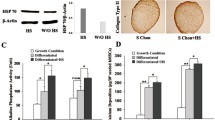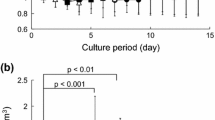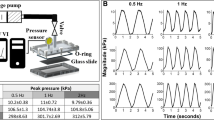Abstract
Conditioning protocols involving mechanical stress independently or with chemical cues such as growth factors (GFs) possess significant potential to enhance bone regeneration. However, utilization of thermal stress conditioning alone or with GFs for bone therapy has been under-investigated. In this study, a preosteoblast cell line (MC3T3-E1) was exposed to treatment with water bath heating (44°C, 4 and 8 min) and osteoinductive GFs (bone morphogenetic protein-2 and transforming growth factor-β1) individually or in combination to investigate whether these stimuli could promote induction of bone-related markers, an angiogenic factor, and heat shock proteins (HSPs). Cells remained viable when heating durations were less than 20 min at 40ºC, 16 min at 42ºC, and 10 min at 44ºC. Increasing heating duration at 44°C, promoted gene expression of HSPs, osteocalcin (OCN), and osteopontin (OPN) at 8 h post-heating (PH). Heating in combination with GFs caused the greatest gene induction of osteoprotegerin (OPG; 6.9- and 1.6-fold induction compared to sham-treated and GF only treated groups, respectively) and vascular endothelial growth factor (VEGF; 16.0- and 1.6-fold compared to sham and GF-only treated groups, respectively) at 8 h PH. Both heating and GFs independently suppressed the matrix metalloproteinase-9 (MMP-9) gene. GF treatment caused a more significant decrease in MMP-9 protein secretion to non-detectable levels compared to heating alone at 72 h PH. Secretion of OCN, OPN, and OPG increased with the addition of GFs but diminished with heating as measured by ELISA at 72 h PH. These results suggest that conditioning protocols utilizing heating and GFs individually or in combination can induce HSPs, bone-related proteins, and VEGF while also causing downregulation of osteoclastic activity, potentially providing a promising bone therapeutic strategy.






Similar content being viewed by others
References
Teitelbaum SL (2000) Osteoclasts, integrins, and osteoporosis. J Bone Miner Metab 18(6):344–349
Singh SP et al (2007) Cyclic mechanical strain increases production of regulators of bone healing in cultured murine osteoblasts. J Am Coll Surg 204(3):426–434
Sharp LA, Lee YW, Goldstein AS (2009) Effect of low-frequency pulsatile flow on expression of osteoblastic genes by bone marrow stromal cells. Ann Biomed Eng 37(3):445–453
Choi JY et al (1996) Expression patterns of bone-related proteins during osteoblastic differentiation in MC3T3-E1 cells. J Cell Biochem 61(4):609–618
Kandziora F et al (2002) IGF-I and TGF-beta1 application by a poly-(D,L-lactide)-coated cage promotes intervertebral bone matrix formation in the sheep cervical spine. Spine (Phila Pa 1976) 27(16):1710–1723
Wei G et al (2007) The enhancement of osteogenesis by nano-fibrous scaffolds incorporating rhBMP-7 nanospheres. Biomaterials 28(12):2087–2096
Jeong JC et al (2004) Drynariae Rhizoma promotes osteoblast differentiation and mineralization in MC3T3-E1 cells through regulation of bone morphogenetic protein-2, alkaline phosphatase, type I collagen and collagenase-1. Toxicol In Vitro 18(6):829–834
Zhang F et al (2009) Sustained BMP signaling in osteoblasts stimulates bone formation by promoting angiogenesis and osteoblast differentiation. J Bone Miner Res 24(7):1224–1233
Ryoo HM, Lee MH, Kim YJ (2006) Critical molecular switches involved in BMP-2-induced osteogenic differentiation of mesenchymal cells. Gene 366(1):51–57
Spinella-Jaegle S et al (2001) Opposite effects of bone morphogenetic protein-2 and transforming growth factor-beta1 on osteoblast differentiation. Bone 29(4):323–330
Peterson WJ, Tachiki KH, Yamaguchi DT (2004) Serial passage of MC3T3-E1 cells down-regulates proliferation during osteogenesis in vitro. Cell Prolif 37(5):325–336
Carano RA, Filvaroff EH (2003) Angiogenesis and bone repair. Drug Discov Today 8(21):980–989
Dai J, Rabie AB (2007) VEGF: an essential mediator of both angiogenesis and endochondral ossification. J Dent Res 86(10):937–950
Street J et al (2002) Vascular endothelial growth factor stimulates bone repair by promoting angiogenesis and bone turnover. Proc Natl Acad Sci U S A 99(15):9656–9661
Harder Y et al (2004) Improved skin flap survival after local heat preconditioning in pigs. J Surg Res 119(1):100–105
Riederer I et al (2008) Heat shock treatment increases engraftment of transplanted human myoblasts into immunodeficient mice. Transplant Proc 40(2):624–630
Hojo T et al (2003) Effect of heat stimulation on viability and proteoglycan metabolism of cultured chondrocytes: preliminary report. J Orthop Sci 8(3):396–399
Lee MW et al (2008) Heat stress induces alkaline phosphatase activity and heat shock protein 25 expression in cultured pulp cells. Int Endod J 41(2):158–162
Wang S et al (2008) HSP70 kinetics study by continuous observation of HSP-GFP fusion protein expression on a perfusion heating stage. Biotechnol Bioeng 99(1):146–154
Rylander MN et al (2005) Correlation of HSP70 expression and cell viability following thermal stimulation of bovine aortic endothelial cells. J Biomech Eng 127(5):751–757
Shui C, Scutt A (2001) Mild heat shock induces proliferation, alkaline phosphatase activity, and mineralization in human bone marrow stromal cells and Mg-63 cells in vitro. J Bone Miner Res 16(4):731–741
Yoshida K et al (2009) Influence of heat stress to matrix on bone formation. Clin Oral Implants Res 20:782–790
Ye CP et al (2007) Culture media conditioned by heat-shocked osteoblasts enhances the osteogenesis of bone marrow-derived mesenchymal stromal cells. Cell Biochem Funct 25(3):267–276
Leon SA et al (1993) Effects of hyperthermia on bone. II. Heating of bone in vivo and stimulation of bone growth. Int J Hyperthermia 9(1):77–87
Mestril R et al (1994) Isolation of a novel inducible rat heat-shock protein (HSP70) gene and its expression during ischaemia/hypoxia and heat shock. Biochem J 298(Pt 3):561–569
Wang S, Diller KR, Aggarwal SJ (2003) Kinetics study of endogenous heat shock protein 70 expression. J Biomech Eng 125(6):794–797
Lee J et al (2009) Controlled delivery of heat shock protein using an injectable microsphere/hydrogel combination system for the treatment of myocardial infarction. J Control Release 137(3):196–202
Cooper LF et al (2000) Estrogen-induced resistance to osteoblast apoptosis is associated with increased hsp27 expression. J Cell Physiol 185(3):401–407
Hebb MO, Myers TL, Clarke DB (2006) Enhanced expression of heat shock protein 27 is correlated with axonal regeneration in mature retinal ganglion cells. Brain Res 1073–1074:146–150
Laplante AF et al (1998) Expression of heat shock proteins in mouse skin during wound healing. J Histochem Cytochem 46(11):1291–1301
Russotti G et al (1997) Studies of heat and PGA(1)-induced cold tolerance show that HSP27 may help preserve actin morphology during hypothermia. Tissue Engineering 3(2):135–147
Lanneau D et al (2007) Apoptosis versus cell differentiation: role of heat shock proteins HSP90, HSP70 and HSP27. Prion 1(1):53–60
Hatakeyama D et al (2002) Upregulation by retinoic acid of transforming growth factor-beta-stimulated heat shock protein 27 induction in osteoblasts: involvement of mitogen-activated protein kinases. Biochim Biophys Acta 1589(1):15–30
Cooper LF, Uoshima K (1994) Differential estrogenic regulation of small M(r) heat shock protein expression in osteoblasts. J Biol Chem 269(11):7869–7873
Tokuda H et al (2003) Involvement of stress-activated protein kinase/c-Jun N-terminal kinase in endothelin-1-induced heat shock protein 27 in osteoblasts. Eur J Endocrinol 149(3):239–245
Kozawa O et al (2001) Mechanism of prostaglandin D(2)-stimulated heat shock protein 27 induction in osteoblasts. Cell Signal 13(8):535–541
Nagata K (1998) Expression and function of heat shock protein 47: a collagen-specific molecular chaperone in the endoplasmic reticulum. Matrix Biol 16(7):379–386
Dafforn TR, Della M, Miller AD (2001) The molecular interactions of heat shock protein 47 (Hsp47) and their implications for collagen biosynthesis. J Biol Chem 276(52):49310–49319
Yamamura I et al (1998) Transcriptional activation of the mouse HSP47 gene in mouse osteoblast MC3T3-E1 cells by TGF-beta 1. Biochem Biophys Res Commun 244(1):68–74
Tiffee JC, Griffin JP, Cooper LF (2000) Immunolocalization of stress proteins and extracellular matrix proteins in the rat tibia. Tissue Cell 32(2):141–147
Garrido C et al (2006) Heat shock proteins 27 and 70: anti-apoptotic proteins with tumorigenic properties. Cell Cycle 5(22):2592–2601
Terauchi R et al (2003) Hsp70 prevents nitric oxide-induced apoptosis in articular chondrocytes. Arthritis Rheum 48(6):1562–1568
Dressel R et al (2000) Heat shock protein 70 is able to prevent heat shock-induced resistance of target cells to CTL. J Immunol 164(5):2362–2371
Klein-Nulend J et al (1997) Mechanical stimulation of osteopontin mRNA expression and synthesis in bone cell cultures. J Cell Physiol 170(2):174–181
Shea LD et al (2000) Engineered bone development from a pre-osteoblast cell line on three-dimensional scaffolds. Tissue Eng 6(6):605–617
Tang L, Lin Z, Li YM (2006) Effects of different magnitudes of mechanical strain on osteoblasts in vitro. Biochem Biophys Res Commun 344(1):122–128
Mizutani A et al (2001) Expression of matrix metalloproteinases during ascorbate-induced differentiation of osteoblastic MC3T3-E1 cells. J Bone Miner Res 16(11):2043–2049
Santos MI, Reis RL (2009) Vascularization in bone tissue engineering: physiology, current strategies, major hurdles and future challenges. Macromol Biosci 10(1):12–27
Aubin JE, Bonnelye E (2000) Osteoprotegerin and its ligand: a new paradigm for regulation of osteoclastogenesis and bone resorption. Osteoporos Int 11(11):905–913
Kaneshita Y, Goda S, Kawamoto T (2007) The effect of matrix metalloproteinase-9 on the differentiation into osteoclast cells on RAW264 cells. Orthodontic Waves 66(4):122–128
Rodan GA, Martin TJ (2000) Therapeutic approaches to bone diseases. Science 289(5484):1508–1514
Rylander MN et al (2010) Measurement and mathematical modeling of thermally induced injury and heat shock protein expression kinetics in normal and cancerous prostate cells. Int J Hyperthermia 26(8):748–764
Chung CY et al (1999) Serial passage of MC3T3-E1 cells alters osteoblastic function and responsiveness to transforming growth factor-beta1 and bone morphogenetic protein-2. Biochem Biophys Res Commun 265(1):246–251
Lee YW et al (2004) Gene expression profile in interleukin-4-stimulated human vascular endothelial cells. Mol Med 10(1–6):19–27
Russotti G et al (1996) Induction of tolerance to hypothermia by previous heat shock using human fibroblasts in culture. Cryobiology 33(5):567–580
Luna C et al (2009) Alterations in gene expression induced by cyclic mechanical stress in trabecular meshwork cells. Mol Vis 15:534–544
Kaarniranta K et al (2003) Stress responses of mammalian cells to high hydrostatic pressure. Biorheology 40(1–3):87–92
Sawatzky DA et al (2005) Heat-shock proteins and their role in chondrocyte protection, an application for autologous transplantation. Inflammopharmacology 12(5–6):569–589
Cao Y et al (1999) TGF-beta1 mediates 70-kDa heat shock protein induction due to ultraviolet irradiation in human skin fibroblasts. Pflugers Arch 438(3):239–244
Hayashi K et al (2008) (−)-Epigallocatechin gallate reduces transforming growth factor beta-stimulated HSP27 induction through the suppression of stress-activated protein kinase/c-Jun N-terminal kinase in osteoblasts. Life Sci 82(19–20):1012–1017
Matsuo K (2009) Cross-talk among bone cells. Curr Opin Nephrol Hypertens 18(4):292–297
Grellier M, Bordenave L, Amedee J (2009) Cell-to-cell communication between osteogenic and endothelial lineages: implications for tissue engineering. Trends Biotechnol 27(10):562–571
Einhorn TA (2003) Cox-2: where are we in 2003?—The role of cyclooxygenase-2 in bone repair. Arthritis Res Ther 5(1):5–7
O’Keefe RJ et al (2006) COX-2 has a critical role during incorporation of structural bone allografts. Skeletal Development and Remodeling in Health, Disease, and Aging 1068:532–542
Sato MM et al (2009) Bone morphogenetic protein-2 enhances Wnt/beta-catenin signaling-induced osteoprotegerin expression. Genes Cells 14(2):141–153
Takai H et al (1998) Transforming growth factor-beta stimulates the production of osteoprotegerin/osteoclastogenesis inhibitory factor by bone marrow stromal cells. J Biol Chem 273(42):27091–27096
Grundt A et al (2009) Direct effects of osteoprotegerin on human bone cell metabolism. Biochem Biophys Res Commun 389:550–555
Hurley NE et al (2010) Modulating the functional contributions of c-Myc to the human endothelial cell cyclic strain response. J Vasc Res 47(1):80–90
Deckers MM et al (2002) Bone morphogenetic proteins stimulate angiogenesis through osteoblast-derived vascular endothelial growth factor A. Endocrinology 143(4):1545–1553
Gong B et al (2006) Whole-body hyperthermia induces up-regulation of vascular endothelial growth factor accompanied by neovascularization in cardiac tissue. Life Sci 79(19):1781–1788
Funding sources
The following are the funding sources of this work: National Science Foundation grant CBET 0966546 and Institute for Critical Technologies and Applied Sciences (ICTAS) at Virginia Tech.
Conflict of interest
All authors have no conflicts of interest.
Author information
Authors and Affiliations
Corresponding author
Rights and permissions
About this article
Cite this article
Chung, E., Rylander, M.N. Response of preosteoblasts to thermal stress conditioning and osteoinductive growth factors. Cell Stress and Chaperones 17, 203–214 (2012). https://doi.org/10.1007/s12192-011-0300-8
Received:
Revised:
Accepted:
Published:
Issue Date:
DOI: https://doi.org/10.1007/s12192-011-0300-8




